中华核医学与分子影像杂志 投稿须知
- 格式:doc
- 大小:49.00 KB
- 文档页数:6

中华结核和呼吸杂志投稿格式中华结核和呼吸杂志投稿格式一、前言中华结核和呼吸杂志作为中国呼吸学会官方杂志,拥有丰富的学术资源和广泛的读者群体。
在投稿之前,了解中华结核和呼吸杂志的投稿格式和要求,有利于稿件的顺利发表。
本文将为大家介绍中华结核和呼吸杂志投稿格式的相关内容,希望能对投稿者提供一定帮助。
二、投稿要求1.主题中华结核和呼吸杂志主要刊载呼吸系统疾病相关的原创性实验研究、基础研究、临床研究、病例报告、学术综述、专家观点等方面的论文。
2.投稿方式中华结核和呼吸杂志接受在线投稿和邮件投稿两种方式,投稿人可根据自身情况选择投稿方式。
3.文章排版中华结核和呼吸杂志鼓励投稿作者使用Word软件编辑投稿内容,并注意排版格式。
每篇论文应为A4纸张,单倍行距、1.5倍行距和2号字体的格式,页边距设置为2.54厘米。
4.文字要求论文应使用标准汉语写作,文献引用需按照GB/T7714标准格式。
5.页眉页脚每一页论文均需标注页眉和页脚,页眉包括论文题目和作者姓名,页脚包括页码。
三、投稿流程1.在线投稿投稿者可访问中华结核和呼吸杂志官网,进入“在线投稿”页面,并按照要求填写相应的投稿信息和上传论文。
在线投稿时,请务必填写真实准确的联系方式,以便编辑部联系审稿人或通知作者论文状态。
2.邮件投稿投稿人可将论文编辑成Word格式的文档,通过邮件的方式发送到中华结核和呼吸杂志的指定邮箱。
请注意邮件主题应注明“中华结核和呼吸杂志投稿”,并在邮件正文中附上作者信息及其他相关信息。
3.审稿流程论文接受后,中华结核和呼吸杂志编辑部将会把文章分配给2-3名专家进行审稿。
审稿专家将详细审阅稿件,并根据相应的标准进行评价。
稿件被接受后,编辑部将与作者联系,并进行后续的排版和修订。
四、注意事项1. 遵循学术规范投稿人应遵循学术规范和道德规范,力求论文真实、客观、准确,严禁抄袭、剽窃、篡改他人研究成果并贩卖虚假数据。
2. 投稿时间中华结核和呼吸杂志对投稿时间无要求,投稿人可根据自身情况随时进行投稿。
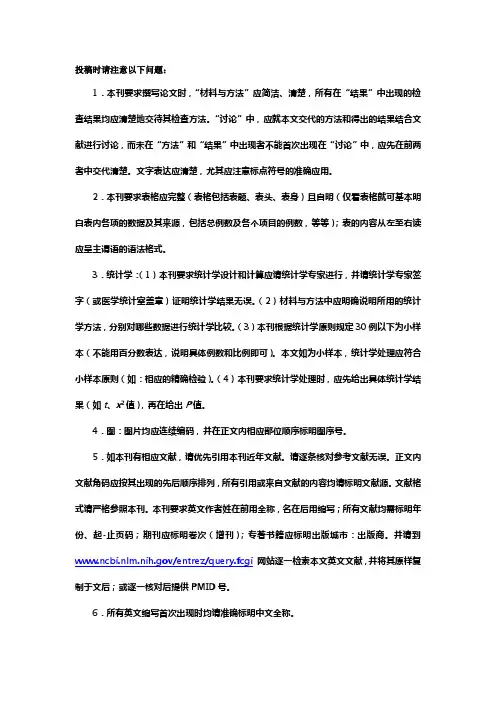
投稿时请注意以下问题:1.本刊要求撰写论文时,“材料与方法”应简洁、清楚,所有在“结果”中出现的检查结果均应清楚地交待其检查方法。
“讨论”中,应就本文交代的方法和得出的结果结合文献进行讨论,而未在“方法”和“结果”中出现者不能首次出现在“讨论”中,应先在前两者中交代清楚。
文字表达应清楚,尤其应注意标点符号的准确应用。
2.本刊要求表格应完整(表格包括表题、表头、表身)且自明(仅看表格就可基本明白表内各项的数据及其来源,包括总例数及各个项目的例数,等等);表的内容从左至右读应呈主谓语的语法格式。
3.统计学:(1)本刊要求统计学设计和计算应请统计学专家进行,并请统计学专家签字(或医学统计室盖章)证明统计学结果无误。
(2)材料与方法中应明确说明所用的统计学方法,分别对哪些数据进行统计学比较。
(3)本刊根据统计学原则规定30例以下为小样本(不能用百分数表达,说明具体例数和比例即可)。
本文如为小样本,统计学处理应符合小样本原则(如:相应的精确检验)。
(4)本刊要求统计学处理时,应先给出具体统计学结果(如t、x2值),再在给出P值。
4.图:图片均应连续编码,并在正文内相应部位顺序标明图序号。
5.如本刊有相应文献,请优先引用本刊近年文献。
请逐条核对参考文献无误。
正文内文献角码应按其出现的先后顺序排列,所有引用或来自文献的内容均请标明文献源。
文献格式请严格参照本刊。
本刊要求英文作者姓在前用全称,名在后用缩写;所有文献均需标明年份、起-止页码;期刊应标明卷次(增刊);专著书籍应标明出版城市:出版商。
并请到/entrez/query.fcgi网站逐一检索本文英文文献,并将其原样复制于文后;或逐一核对后提供PMID号。
6.所有英文缩写首次出现时均请准确标明中文全称。
7.中英文摘要的结果中应包含本文结果的主要数据,摘要应简洁、干练。
8.讨论:应针对本文提出的问题及所得结果结合文献进行讨论,应总结出本文的特点。
讨论应简洁、明了,为避免重复、方便读者,讨论的各段前请冠以小标题,小标题应清楚明确。
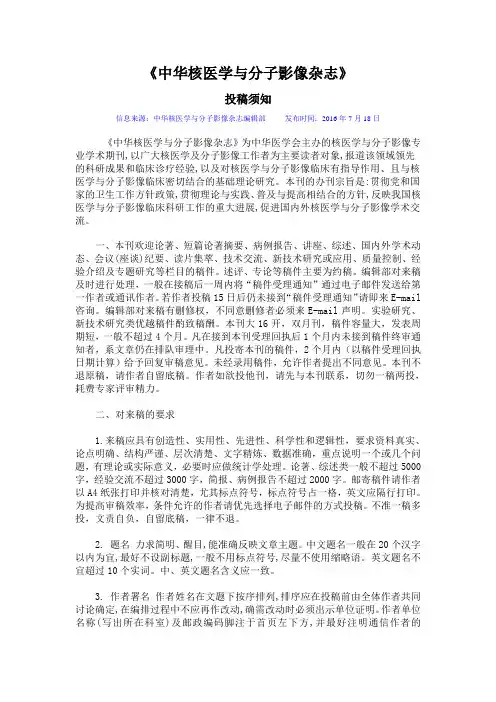
《中华核医学与分子影像杂志》投稿须知信息来源:中华核医学与分子影像杂志编辑部发布时间:2016年7月18日《中华核医学与分子影像杂志》为中华医学会主办的核医学与分子影像专业学术期刊,以广大核医学及分子影像工作者为主要读者对象,报道该领域领先的科研成果和临床诊疗经验,以及对核医学与分子影像临床有指导作用、且与核医学与分子影像临床密切结合的基础理论研究。
本刊的办刊宗旨是:贯彻党和国家的卫生工作方针政策,贯彻理论与实践、普及与提高相结合的方针,反映我国核医学与分子影像临床科研工作的重大进展,促进国内外核医学与分子影像学术交流。
一、本刊欢迎论著、短篇论著摘要、病例报告、讲座、综述、国内外学术动态、会议(座谈)纪要、读片集萃、技术交流、新技术研究或应用、质量控制、经验介绍及专题研究等栏目的稿件。
述评、专论等稿件主要为约稿。
编辑部对来稿及时进行处理,一般在接稿后一周内将“稿件受理通知”通过电子邮件发送给第一作者或通讯作者。
若作者投稿15日后仍未接到“稿件受理通知”请即来E-mail 咨询。
编辑部对来稿有删修权,不同意删修者必须来E-mail声明。
实验研究、新技术研究类优越稿件酌致稿酬。
本刊大16开,双月刊,稿件容量大,发表周期短,一般不超过4个月。
凡在接到本刊受理回执后1个月内未接到稿件终审通知者,系文章仍在排队审理中。
凡投寄本刊的稿件,2个月内(以稿件受理回执日期计算)给予回复审稿意见。
未经录用稿件,允许作者提出不同意见。
本刊不退原稿,请作者自留底稿。
作者如欲投他刊,请先与本刊联系,切勿一稿两投,耗费专家评审精力。
二、对来稿的要求1.来稿应具有创造性、实用性、先进性、科学性和逻辑性,要求资料真实、论点明确、结构严谨、层次清楚、文字精炼、数据准确,重点说明一个或几个问题,有理论或实际意义,必要时应做统计学处理。
论著、综述类一般不超过5000字,经验交流不超过3000字,简报、病例报告不超过2000字。
邮寄稿件请作者以A4纸张打印并核对清楚,尤其标点符号,标点符号占一格,英文应隔行打印。

《中华放射学杂志》投稿须知信息来源:《中华放射学杂志》编辑部作者:发布时间:2015-1-13 《中华放射学杂志》为中华医学会主办的放射学专业学术期刊,以广大放射学工作者为主要读者对象,报道放射学领域领先的科研成果和临床诊疗经验,以及对放射学临床有指导作用、且与放射学临床密切结合的基础理论研究。
本刊的办刊宗旨是:贯彻党和国家的卫生工作方针政策,贯彻理论与实践、普及与提高相结合的方针,反映我国放射学临床科研工作的重大进展,促进国内外放射学学术交流。
本刊实行同行审稿制,所收稿件均经相关专业专家评审。
一、本刊欢迎论著类、病例报告、急诊经验、综合报道、经验介绍、技术交流、讲座、综述、会议(座谈)纪要、临床病理(病例)讨论、读片集萃、国内外学术动态、医学见闻等类型的稿件。
述评、专论及专家论坛等稿件主要为约稿。
来稿邮箱:zhfsxqk@二、对来稿的要求1.文稿应具有科学性、实用性,论点明确,资料可靠,文字精炼,层次清楚,数据准确,书写工整规范,必要时应做统计学处理。
论著类、综述、讲座等一般不超过5000字,病例报告、简报等不超过1500字。
2.文题:力求简明、醒目,反映出文章的主题。
中文文题一般以20个汉字以内为宜。
3.作者:投稿时作者姓名须另页书写,按序排列,排序应在投稿时确定,在编排过程中不应再作更动;作者单位名称及邮政编码、常用联络电话、Email地址注于同页。
作者应是:(1)参与选题和设计,或参与资料的分析和解释者;(2)起草或修改论文中关键性理论或其他主要内容者;(3)能对编辑部的修改意见进行核修,在学术界进行答辩,并最终同意该文发表者。
以上3条均需具备。
仅参与获得资金或收集资料者不能列为作者,仅对科研小组进行一般管理也不宜列为作者。
对文章中的各主要结论,均必须至少有1位作者负责。
集体署名的文章必须明确对该文负责的关键人物,指定通信作者;其他对该研究有贡献者应列入志谢部分。
作者中如有外籍作者,应征得本人同意,并有证明信。
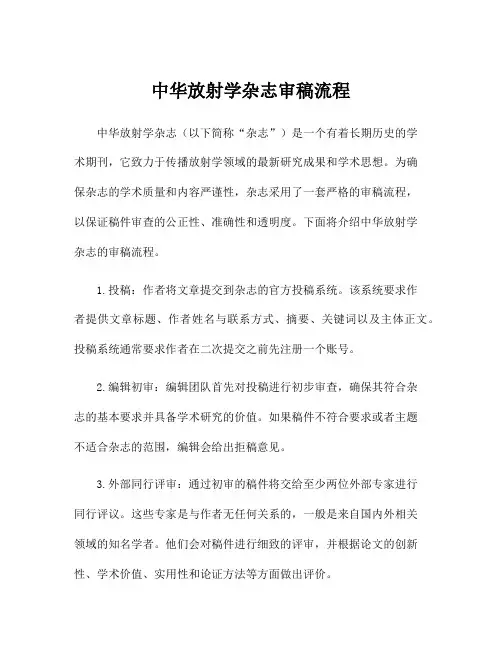
中华放射学杂志审稿流程中华放射学杂志(以下简称“杂志”)是一个有着长期历史的学术期刊,它致力于传播放射学领域的最新研究成果和学术思想。
为确保杂志的学术质量和内容严谨性,杂志采用了一套严格的审稿流程,以保证稿件审查的公正性、准确性和透明度。
下面将介绍中华放射学杂志的审稿流程。
1.投稿:作者将文章提交到杂志的官方投稿系统。
该系统要求作者提供文章标题、作者姓名与联系方式、摘要、关键词以及主体正文。
投稿系统通常要求作者在二次提交之前先注册一个账号。
2.编辑初审:编辑团队首先对投稿进行初步审查,确保其符合杂志的基本要求并具备学术研究的价值。
如果稿件不符合要求或者主题不适合杂志的范围,编辑会给出拒稿意见。
3.外部同行评审:通过初审的稿件将交给至少两位外部专家进行同行评议。
这些专家是与作者无任何关系的,一般是来自国内外相关领域的知名学者。
他们会对稿件进行细致的评审,并根据论文的创新性、学术价值、实用性和论证方法等方面做出评价。
4.审稿意见:评审专家会提出详细的审稿意见,包括对论文中存在的问题指出,对论文的改进和修订提出建议。
这些意见由编辑整理后,返回给作者。
5.作者回复:作者根据专家的审稿意见,进行修改和回复,解答专家提出的问题,并且提供修改后的版本。
6.再次评审:经过修改后的稿件将再次提交给评审专家进行再次评审。
评审专家会根据作者的回复和修改情况,审查文章是否得到了改进并达到发表的要求。
7.最终决定:编辑根据评审专家的建议和论文的质量,作出最终决定。
可能的结果包括接受、拒绝或者要求进行进一步修改和完善。
编辑会将决定结果通知给作者,同时提供评审意见的摘要。
8.出版:一旦稿件被接受,杂志将进行排版和编辑工作,并将文章刊发于指定期刊上。
一般情况下,稿件将以在线电子版和印刷版的形式同时出版。
总的来说,中华放射学杂志的审稿流程十分严谨和标准化。
通过多轮同行评审,杂志确保了学术论文的质量和可靠性,保证了读者能够获得高质量的学术信息。
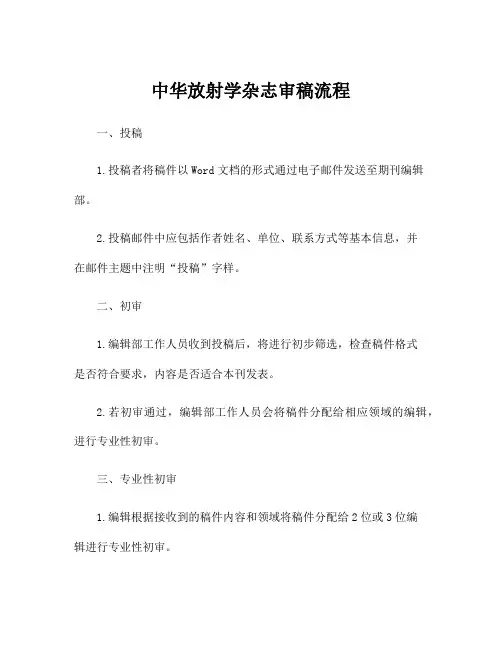
中华放射学杂志审稿流程一、投稿1.投稿者将稿件以Word文档的形式通过电子邮件发送至期刊编辑部。
2.投稿邮件中应包括作者姓名、单位、联系方式等基本信息,并在邮件主题中注明“投稿”字样。
二、初审1.编辑部工作人员收到投稿后,将进行初步筛选,检查稿件格式是否符合要求,内容是否适合本刊发表。
2.若初审通过,编辑部工作人员会将稿件分配给相应领域的编辑,进行专业性初审。
三、专业性初审1.编辑根据接收到的稿件内容和领域将稿件分配给2位或3位编辑进行专业性初审。
2.专业性初审主要包括对稿件的学术水平、研究价值、创新性等方面进行评估。
3.根据专业性初审的结果,编辑部将通知投稿者接收或者拒绝稿件。
四、外部评审1.若稿件通过专业性初审,编辑部会邀请至少2位同领域专家进行外部评审。
2.外部评审主要包括对稿件的学术水平、研究方法、结论等方面进行评估,并提出修改意见。
3.根据外部评审结果,编辑部将通知投稿者接收或者拒绝稿件,或者要求进行再审稿。
五、再审稿1.若编辑部要求再审稿,投稿者需按照外部评审意见对稿件进行修改,并在规定时间内将修改后的稿件重新提交。
2.再审稿将再次经过专业性初审和外部评审。
六、最终审稿1.经过再审稿后,编辑部将进行最终审稿,对稿件的学术性和语言表达等方面进行审核。
2.最终稿件符合要求,编辑部将通知投稿者稿件被录用。
七、录用1.编辑部将录用通知发送至作者,并要求作者签署《稿件版权转让协议》。
2.作者完成版权转让后,编辑部将安排稿件进行排版和定稿。
八、发表1.经过排版和定稿后,稿件将进入印刷流程,最终发表在中华放射学杂志上。
总结:中华放射学杂志审稿流程严格规范,对稿件的学术性和质量有严格要求,力求保证发表的文章具有学术价值和可读性。
同时,编辑部在流程中保障了作者的知识产权,确保稿件的发表和版权转让过程合法、合规。
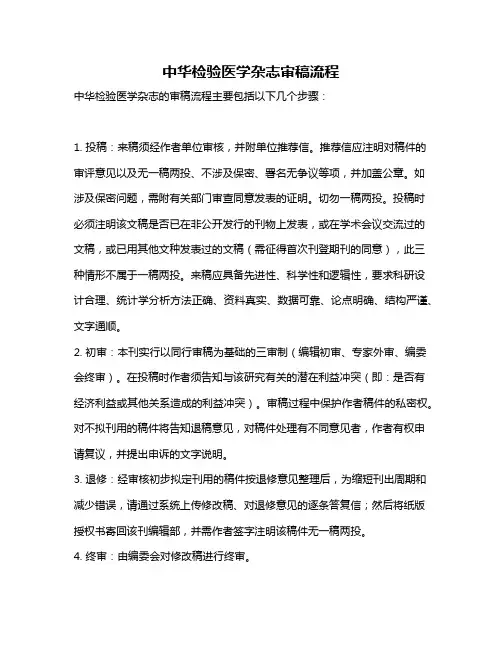
中华检验医学杂志审稿流程中华检验医学杂志的审稿流程主要包括以下几个步骤:1. 投稿:来稿须经作者单位审核,并附单位推荐信。
推荐信应注明对稿件的审评意见以及无一稿两投、不涉及保密、署名无争议等项,并加盖公章。
如涉及保密问题,需附有关部门审查同意发表的证明。
切勿一稿两投。
投稿时必须注明该文稿是否已在非公开发行的刊物上发表,或在学术会议交流过的文稿,或已用其他文种发表过的文稿(需征得首次刊登期刊的同意),此三种情形不属于一稿两投。
来稿应具备先进性、科学性和逻辑性,要求科研设计合理、统计学分析方法正确、资料真实、数据可靠、论点明确、结构严谨、文字通顺。
2. 初审:本刊实行以同行审稿为基础的三审制(编辑初审、专家外审、编委会终审)。
在投稿时作者须告知与该研究有关的潜在利益冲突(即:是否有经济利益或其他关系造成的利益冲突)。
审稿过程中保护作者稿件的私密权。
对不拟刊用的稿件将告知退稿意见,对稿件处理有不同意见者,作者有权申请复议,并提出申诉的文字说明。
3. 退修:经审核初步拟定刊用的稿件按退修意见整理后,为缩短刊出周期和减少错误,请通过系统上传修改稿、对退修意见的逐条答复信;然后将纸版授权书寄回该刊编辑部,并需作者签字注明该稿件无一稿两投。
4. 终审:由编委会对修改稿进行终审。
5. 决定刊用:如果编委会同意刊用该文稿,编辑部会通知作者按照有关规定交纳版面费。
6. 修改与发表:对于决定刊用的文稿,编辑部可以进行文字修改和删节,但涉及原意的修改需要征得作者的认可。
如果稿件在一个月内未返回编辑部进行修改,则会被视为自动撤稿。
一旦文稿被接受并刊登,其著作权归中华医学会所有,中华医学会有权以电子期刊、光盘版等其他方式出版该论文。
未经中华医学会同意,该论文的任何部分不得转载他处。
7. 通知与支付费用:文稿一旦被接受并刊登,编辑部会通知作者支付版面费和可能的彩图印制工本费。
版面费和彩图印制工本费应由作者单位从课题基金、科研费或其他费用中支付。

中华放射学杂志审稿流程中华放射学杂志是一个学术期刊,旨在发布与放射学相关的高质量研究论文和学术成果。
为了确保所发布的论文质量,该杂志采用了一套严格的审稿流程。
以下是中华放射学杂志审稿流程的详细描述。
第一步:稿件提交作者将论文通过电子邮件或在线投稿系统提交给中华放射学杂志。
在投稿时,作者需要提供论文的详细信息,包括标题、作者姓名、单位、联系方式等。
第二步:初步评估编辑部收到稿件后,首先会进行初步评估。
这一步骤的目的是确定论文是否适合该杂志的出版范围,并符合基本的学术要求。
如果论文不符合要求,编辑部可能会拒绝接受投稿并通知作者。
如果论文被接受,将进入下一步的评审过程。
第三步:同行评审中华放射学杂志采用了同行评审制度,即通过专家学者对论文进行匿名评审。
编辑部会邀请两位或更多相关领域的专家学者,他们将对论文进行评审并提供具体的建议和意见。
评审的内容主要包括以下几个方面:1.学术质量:评估论文的研究方法、实验设计、数据处理和分析等是否科学合理。
2.创新性:评估论文的创新性和原创性程度。
3.学术价值:评估论文对学术领域的贡献程度。
4.文章结构:评估论文的结构是否清晰,论述是否连贯,语言是否准确、简明。
评审专家将根据自己的判断和经验,为论文提供评语并给出建议。
评审过程通常需要2-4周的时间。
第四步:编辑决策编辑部根据专家评审的意见和建议,决定对论文做出以下三种决策之一:1.接受:论文直接被接受,准备进入后续的出版流程。
2.修改:论文需要进行一定的修改和改进,以满足杂志的发表要求。
修改后的论文将再次提交给编辑部进行最终审核。
3.拒绝:基于专家评审的意见,编辑部认为论文无法满足杂志的发表要求,因此拒绝发布。
第五步:论文修改如果论文被要求修改,作者需要根据专家评审的意见和建议对论文进行修改。
修改后的论文将再次提交给编辑部。
第六步:最终审核编辑部会对修改后的论文进行最终审核,以确保修改已符合要求。
如果论文通过最终审核,将进入下一步的出版流程。
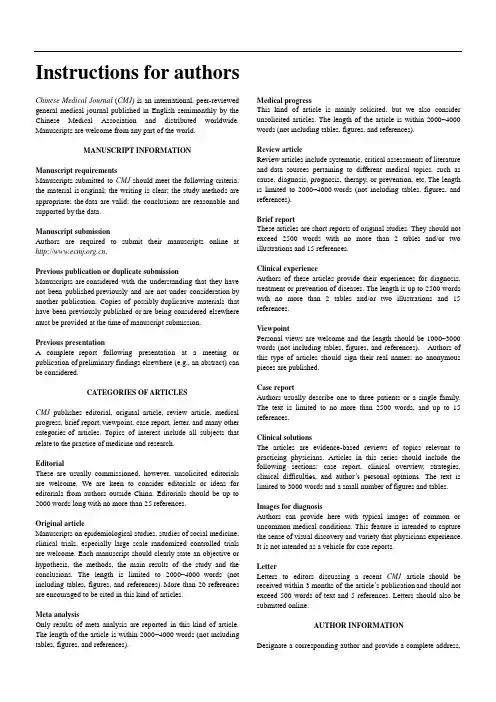
Instructions for authorsChinese Medical Journal (CMJ) is an international, peer-reviewed general medical journal published in English semimonthly by the Chinese Medical Association and distributed worldwide. Manuscripts are welcome from any part of the world.MANUSCRIPT INFORMATIONManuscript requirementsManuscripts submitted to CMJ should meet the following criteria: the material is original; the writing is clear; the study methods are appropriate; the data are valid; the conclusions are reasonable and supported by the data.Manuscript submissionAuthors are required to submit their manuscripts online at .Previous publication or duplicate submissionManuscripts are considered with the understanding that they have not been published previously and are not under consideration by another publication. Copies of possibly duplicative materials that have been previously published or are being considered elsewhere must be provided at the time of manuscript submission.Previous presentationA complete report following presentation at a meeting or publication of preliminary findings elsewhere (e.g., an abstract) can be considered.CATEGORIES OF ARTICLESCMJ publishes editorial, original article, review article, medical progress, brief report,viewpoint, case report, letter, and many other categories of articles. Topics of interest include all subjects that relate to the practice of medicine and research.EditorialThese are usually commissioned, however, unsolicited editorials are welcome. We are keen to consider editorials or ideas for editorials from authors outside China. Editorials should be up to 2000 words long with no more than 25 references.Original articleManuscripts on epidemiological studies, studies of social medicine, clinical trials, especially large scale randomized controlled trials are welcome. Each manuscript should clearly state an objective or hypothesis, the methods, the main results of the study and the conclusions. The length is limited to 2000–4000words (not including tables, figures, and references).More than 20 references are encouraged to be cited in this kind of articles.Meta analysisOnly results of meta analysis are reported in this kind of article. The length of the article is within 2000–4000 words (not including tables, figures, and references). Medical progressThis kind of article is mainly solicited, but we also consider unsolicited articles. The length of the article is within 2000–4000 words (not including tables, figures, and references).Review articleReview articles include systematic, critical assessments of literature and data sources pertaining to different medical topics, such as cause, diagnosis, prognosis, therapy, or prevention, etc.The length is limited to 2000–4000words (not including tables, figures, and references).Brief reportThese articles are short reports of original studies. They should not exceed 2500 words with no more than 2 tables and/or two illustrations and 15 references.Clinical experienceAuthors of these articles provide their experiences for diagnosis, treatment or prevention of diseases. The length is up to 2500 words with no more than 2 tables and/or two illustrations and 15 references.ViewpointPersonal views are welcome and the length should be 1000–3000 words (not including tables, figures, and references). Authors of this type of articles should sign their real names; no anonymous pieces are published.Case reportAuthors usually describe one to three patients or a single family. The text is limited to no more than 2500 words, and up to 15 references.Clinical solutionsThe articles are evidence-based reviews of topics relevant to practicing physicians. Articles in this series should include the following sections: case report, clinical overview, strategies, clinical difficulties, and author’s personal opinions. The text is limited to 3000 words and a small number of figures and tables. Images for diagnosisAuthors can provide here with typical images of common or uncommon medical conditions. This feature is intended to capture the sense of visual discovery and variety that physicians experience. It is not intended as a vehicle for case reports.LetterLetters to editors discussing a recent CMJ article should be received within 3 months of the article’s publication and should not exceed 500 words of text and 5 references. Letters should also be submitted online.AUTHOR INFORMATIONDesignate a corresponding author and provide a complete address,telephone and fax numbers, and E-mail address.Authorship requirementsEach author should have participated sufficiently in the work to take public responsibility for appropriate portions of the content. One or more authors should take responsibility for the integrity of the work as a whole, from inception to published article. Authorship credit should be based on(1) substantial contributions to conception and design, or acquisition of data, or analysis and interpretation of data; and (2) drafting the article or revising it critically for important intellectual content; and (3) final approval of the version to be published.Conditions 1, 2, and 3 must all be met.1Group authorshipIf authorship is attributed to a group, all members of the group must meet the full criteria and requirements for authorship as described above. A group must designate at least one individual as corresponding author. Other group members may be listed in an Acknowledgment.Conflicts of interestAuthors should indicate relevant conflicts of interest, including specific financial interests relevant to the subject of their manuscript, in their covering letter. Authors without relevant financial interests in the manuscript should indicate no such interest.EDITORIAL REVIEW AND PUBLICATIONPeer reviewA CMJ editor reviews submitted manuscripts initially. Manuscripts with insufficient priority for publication are rejected promptly. Other manuscripts are sent to expert consultants for peer review. Peer reviewer identities are kept confidential.The manuscript under review is not revealed to anyone other than peer reviewers and editorial staff. We encourage authors to suggest the names of possible reviewers, but we reserve the right of final selection. Rejected manuscriptsRejected manuscripts and reasons for rejection can be found online. EditingAccepted manuscripts are copyedited first by native speakers and then by CMJ editors according to CMJ style and returned to the author for approval. Authors are responsible for all statements made in their work, including changes made by the editor and authorized by the corresponding author.PublicationAuthors are required to pay page fee if their manuscripts are accepted for publication. The publisher will provide the author (s) 2 copies of the journal free of charge.CopyrightThe Chinese Medical Association (CMA) is the owner of all copyrights to any articles published in the journal. Published manuscripts become the permanent property of the Chinese Medical Association and may not be published elsewhere without written permission. Chinese Medical Association keeps the right to use these manuscripts in any form, including print, video, audio, and digital.MANUSCRIPT PREPARATIONManuscripts should be prepared in accordance with the Uniform Requirements for Manuscripts Submitted to Biomedical Journals by the International Committee of Medical Journal Editors (ICMJE) ().Submit the original manuscript online; use 1 side of standard-sized page and 1.5 cm margins.For Chinese authors, submission of a Chinese version of the manuscript (or abstract) is recommended.Use only 10- or 12-point font size.On the title page include the full names and affiliations of all authors. If an author’s affiliation has changed since the work was done, list the new affiliation as well. Titles should be concise and descriptive. The name, address, telephone number, fax number, and E-mail address of the correspondence author should be addressed. Any grant support that requires acknowledgment should be mentioned on this page.Measurements of length, height, weight, and volume should be reported in metric units (meter, kilogram, or liter) or their decimal multiples. Temperatures should be given in degrees Celsius. Blood pressures should be given in millimeters of mercury. All hematological and clinical chemistry measurements should be reported in the metric system in terms of the International System Units (SI).Use nonproprietary names of drugs, devices, and other products, unless the specific trade name of a drug is directly relevant to the discussion.Do not use abbreviations in the title or abstract and limit their use in the text.A covering letter signed by all authors includes(1) information on prior or duplicate publication or submission elsewhere of any part of the study; (2) the statement that the manuscript has been read and approved by all the authors and that the criteria for authorship have been met; (3) the statement on financial or other conflict of interests; and (4) any suggestions such as referring possible unqualified reviewers due to conflict of interests, etc. The corresponding author must sign the acknowledgment statement. Authors should obtain written permission from all individuals named in an acknowledgment.JOURNAL STYLETablesTables should be simple and no duplicate information should appear in the text of the article. Tables should be numbered consecutively, and headed by a concise title. Place explanatory matter in footnotes, not in the heading. Explain in footnotes all non-standard abbreviations that are used in each table. Forfootnotes use the following symbols in this sequence: *, †, ‡, §, ||, ¶, **, ††, ‡‡.FiguresComplete sets of illustrations must be submitted with legends typed on the same page. Only clear photographs are acceptable. All lettering must be legible after reduction to column size. Magnification and staining should be indicated when pertinent. AbbreviationsUse only standard abbreviations. Avoid abbreviations in the title and abstract. The full term for which an abbreviation stands should precede its first use in the text unless it is a standard unit of measurement.Ethical requirementFor experimental investigations of human subjects, state in the Methods section that an appropriate institutional review board approved the project. For those investigators who do not have formal ethics review committees,the principles outlined in the Declaration of Helsinki2 should be followed. For investigations of human subjects, state in the Methods section the manner in which informed consent was obtained from the study participants.Patient descriptions, photographs, and pedigreesInclude a signed statement of informed consent to publish (in print and online) patient descriptions, photographs, and pedigrees from all persons (parents or legal guardians for minors) who can be identified in such written descriptions, photographs, or pedigrees. Such persons should be shown the manuscript before its submission.Permissions required to reproduce or adapt material Acknowledge all text, illustrations, and tables adapted or reproduced from other publications and submit permission from the original publishers(or other copyright owner) to republish in print, online, and licensed versions of CMJ.ReferencesNumber references in the order they appear in the text; do not alphabetize. In text, tables, and legends, identify references with superscript Arabic numerals. When listing references,abbreviate titles of journals according to Medline. Note: List authors and/or editors up to 6; if more than 6, list the first 6 authors followed by et al.Examples of reference style:1. Liu XP, Long DY, Dong JZ, Liu XQ, Fang DP, Hao P, et al. Recurrent atrial tachycardia and atrial fibrillation after circumferential pulmonary vein a blation: What’s the difference? Chin Med J 2005; 118: 1773-1778.2. Xie SZ, Gu MJ, Cheng YP. Inhibitory effect of medroxyprogesterone acetate on angiogenesis induced by malignant neoplasm. Chin J Obstet Gynecol (Chin)* 1998; 33: 113-114.3. Weinstein L, Swartz MN. Pathogenic properties of invading microorganisms. In: Sodeman WA Jr., Sodeman WA, eds. Pathologic physiology: mechanisms of disease. Philadelphia: Saunders; 1974: 457-472.4. Dannenberg AM. Immune mechanisms in the pathogenesis of pulmonary tuberculosis. Rev Infect Dis 1989; 11 Suppl 2: s369-s378.5. Payne DK, Sullivan MD, Massie MJ. Women’s psychological reactions to breast cancer. Semin Oncol 1996; 23(1 Suppl 2): 89-97.6. Ozben T, Nacitarhan S, Tuncer N. Plasma and urine sialic acid in non-insulin dependent diabetes mellitus. Ann Clin Biochem 1995;32 (Pt 3): 303-306.7. Turan I, Wredmark T, Fellander-Tsai L. Arthroscopic ankle arthrodesis in rheumatoid arthritis. Clin Orthop 1995; (320): 110-114.8. Cumulative number of reported cases of severe acute respiratory syndrome (SARS). Geneva: World Health Organization, 2003. (Accessed April 9, 2003 at http://www.who.int/csr/sarscountry/ 2003_04_04/en/.)*: It is especially needed to note “(Chin)” for articles published in Chinese.Authors are responsible for the accuracy and completeness of their references and for correct citation of the text.REPORT OF ORIGINAL DATAAbstractInclude a structured abstract of no more than 300words for original articles, meta analysis, brief report, clinical experience (Background, Methods, Results, Conclusions) and review articles (Objective, Data sources, Study selection, Results, Conclusions); an informative abstract for medical progress, viewpoint, case report, clinical solutions and images for diagnosis.KeywordsThree to 6 words or short phrases should be provided at the top of the abstract page as keywords. Terms from the medical subject heading (MeSH) list of Medline should be used; if suitable MeSH terms are not yet available for recently introduced terms, present terms may be used.IntroductionIntroduction should be short and arresting. State the purpose of the article and summarize the rationale for the study or observation. Give only strictly pertinent references and do not include data or conclusions from the work being reported.MethodsDescribe your selection of the observational or experimental subjects (patients or laboratory animals, including controls) clearly. Identify the age, sex, and other important characteristics of the subjects.Iden tify the methods, apparatus (list the manufacturer’s name and original country in parentheses), and procedures in sufficient detail to allow other workers to reproduce the results. Give references to established methods, including statistical methods; provide references and brief descriptions for methods that have been published but are not well known; describe new or substantially modified methods, give reasons for using them, and evaluate theirlimitations. Identify precisely all drugs and chemicals used, including generic name (s), dose (s), and route (s) of administration.Reports of randomized clinical trials should present information on all major study elements including the protocol (study population, interventions or exposures, outcomes, and the rationale for statistical analysis), assignment of interventions (methods of randomization, concealment of allocation to treatment groups), and the method of masking (blinding). Authors are recommended to refer to the CONSORT Statement 3 for details.ResultsOverall describe the major findings of the study. Present your results in logical sequence in the text, tables and illustrations. Do not repeat in the text all the data in the tables or illustrations; emphasize or summarize only important observations. DiscussionSummarize the major findings. Discuss possible problems with the methods used. Compare your results with previous work. Discuss the clinical and scientific (if any) implications of your findings and their limitations. Suggest further work. Produce a succinct conclusion.MANUSCRIPT CHECKLISTSubmit complete text of your manuscript online (including tables, figures, etc), in addition, domestic authors should submit Chinese version of the complete text or its abstract.Review the sequence: covering letter, title page, key words and abstract, text, acknowledgments, references, tables, legends for illustrations.Check all references for accuracy and completeness. Put references in proper format in numerical order, making sure each is cited in the text.Include written permission from each individual identified as a source for personal communication.Include informed consent forms for identifiable patient descriptions, photographs and pedigrees.Keep copies of everything submitted.Manuscript inquiriesTel:86-10-85158321.Fax:86-10-85158333.Email:***********. cn.REFERENCES1.International Committee of Medical Journal Editors. Uniformrequirements for manuscripts submitted to biomedical journals.(Accessed September 10, 2009 at: )2.World Medical Association. Declaration of Helsinki: Ethicalprinciples for medical research involving human subjects.(Accessed September 6, 2005 at: /e/policy/ pdf/ 17c.pdf)3.Schulz KF, Altman DG, Moher D, for the CONSORT Group.The CONSORT statement: revised recommendations for improving the quality of reports of parallel-group randomized trials. (Accessed October 28, 2010 at: http://www.consort- )。
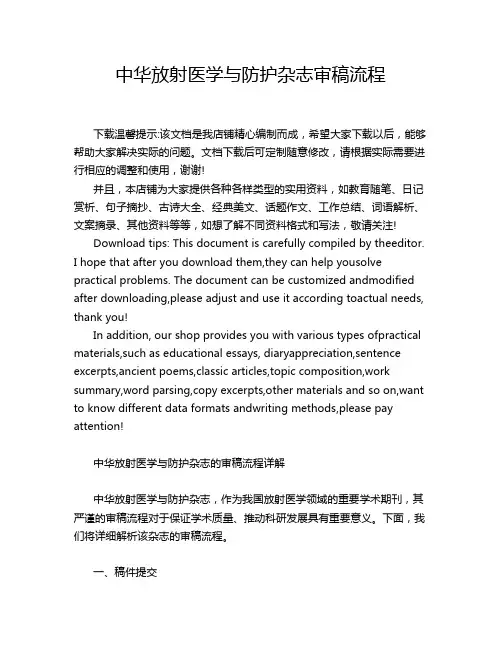
中华放射医学与防护杂志审稿流程下载温馨提示:该文档是我店铺精心编制而成,希望大家下载以后,能够帮助大家解决实际的问题。
文档下载后可定制随意修改,请根据实际需要进行相应的调整和使用,谢谢!并且,本店铺为大家提供各种各样类型的实用资料,如教育随笔、日记赏析、句子摘抄、古诗大全、经典美文、话题作文、工作总结、词语解析、文案摘录、其他资料等等,如想了解不同资料格式和写法,敬请关注!Download tips: This document is carefully compiled by theeditor.I hope that after you download them,they can help yousolve practical problems. The document can be customized andmodified after downloading,please adjust and use it according toactual needs, thank you!In addition, our shop provides you with various types ofpractical materials,such as educational essays, diaryappreciation,sentence excerpts,ancient poems,classic articles,topic composition,work summary,word parsing,copy excerpts,other materials and so on,want to know different data formats andwriting methods,please pay attention!中华放射医学与防护杂志的审稿流程详解中华放射医学与防护杂志,作为我国放射医学领域的重要学术期刊,其严谨的审稿流程对于保证学术质量、推动科研发展具有重要意义。
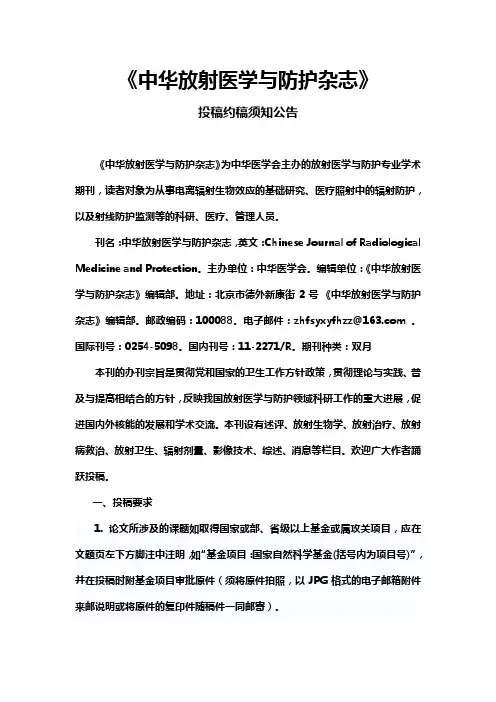
《中华放射医学与防护杂志》投稿约稿须知公告《中华放射医学与防护杂志》为中华医学会主办的放射医学与防护专业学术期刊,读者对象为从事电离辐射生物效应的基础研究、医疗照射中的辐射防护,以及射线防护监测等的科研、医疗、管理人员。
刊名:中华放射医学与防护杂志,英文:Chinese Journal of Radiological Medicine and Protection。
主办单位:中华医学会。
编辑单位:《中华放射医学与防护杂志》编辑部。
地址:北京市德外新康街2号《中华放射医学与防护杂志》编辑部。
邮政编码:100088。
电子邮件:zhfsyxyfhzz@ 。
国际刊号:0254-5098。
国内刊号:11-2271/R。
期刊种类:双月本刊的办刊宗旨是贯彻党和国家的卫生工作方针政策,贯彻理论与实践、普及与提高相结合的方针,反映我国放射医学与防护领域科研工作的重大进展,促进国内外核能的发展和学术交流。
本刊设有述评、放射生物学、放射治疗、放射病救治、放射卫生、辐射剂量、影像技术、综述、消息等栏目。
欢迎广大作者踊跃投稿。
一、投稿要求1. 论文所涉及的课题如取得国家或部、省级以上基金或属攻关项目,应在文题页左下方脚注中注明,如“基金项目:国家自然科学基金(括号内为项目号)”,并在投稿时附基金项目审批原件(须将原件拍照,以JPG格式的电子邮箱附件来邮说明或将原件的复印件随稿件一同邮寄)。
2. 文稿应具有科学性、创新性、实用性,论点明确,资料可靠,文字精炼,层次清楚,数据准确,图表规范,必要时应做统计学处理。
论著、综述类一般不超过5000字,经验交流不超过3000字,简报、病例报告不超过2000字。
邮寄稿件请作者以A4纸张打印并核对清楚,尤其标点符号,标点符号占一格,英文应隔行打印。
为提高审稿效率,条件允许的作者请优先选择电子邮件的方式投稿,本刊全国统一投稿电子邮箱E-mail:zhfsyxyfhzz@16 。
不准一稿多投,文责自负,自留底稿,一律不退。
《中华放射医学与防护杂志》对来稿中插图的要求
《中华放射医学与防护杂志》是一本专业学术杂志,其稿件中的插图必须符合一定的要求,以确保文章的可读性。
首先,所有插图都必须清晰可辨,线条细腻,字体精致。
插图的内容应严谨、准确,要具
备叙述性,不得过于简单或晦涩难懂,并保证其来源的科学性。
此外,插图的尺寸应与稿件的字数大小成正比。
一篇有2000字的稿件,最多可放入3幅
插图,而一篇有500字的稿件,最多可放入1幅插图。
插图尺寸应当适中,不得过大或过小,以免影响文章的整体性。
插图的类型也要慎重选择,应使用不同的插图形式来说明文章的不同观点,如流程图、示
意图、散点图等,以便更好地表达文章的主旨。
另外,插图必须与文章内容相统一,保持一致。
插图要能够有效地补充文章的内容,使读
者能够更加深刻地理解稿件内容,以引发读者的关注。
从以上可以看出,《中华放射医学与防护杂志》对来稿中插图的要求甚为严格。
如果稿件
中插图不能满足要求,有可能引起读者的误解,从而影响文章的影响力,因此,作者应当
把插图放在稿件中,让文章的表达更加准确、形象,从而获得更好的推广效果。
•758•中国介入影像与治疗学2020年第17卷第12期ChinJ Interv Imaging Ther,2020,Vol17,No12transcatheterarterialembolizationforlargeunrupturedrenal angiomyolipoma in lymphangioleiomyomatosis[J].J Vasc Interv Radiol,2010,29(7):950-965.19]PATATAS K,ROBINSON GJ,ETTLESD F,et al.Patterns of renal angiomyolipoma regression post embolisation on medium-to long-term folow-up[J].Br J Radiol,2013,86(1024):20120633.[20]FERNANDEZ-PELLO S,HORA M,KUUSK T,et al.Management of sporadic renal angiomyolipomas:A systematic reviewofavailableevidencetoguiderecommendationsfromthe Europeanassociationofurologyrenalce l carcinomaguidelines panel J.EurUrol Oncol,2020,3(1):57-72.[21]ZAPARDIELI,DELAFUENTE-VALERO J,BAJO-ARENASJ M.Renal angiomyolipoma during pregnancy:Review of the literature J.Gynecol Obstet Invest,2011,72(4):217-219. [22]李新飞,林乐涛,宋莉,等•经皮消融治疗肾血管平滑肌脂肪瘤应用进展[J]•中国介入影像与治疗学,2019,16(7):430-433. [23]CRISTESCU M,ABEL E J,WELLS S,et al Percutaneousmicrowaveablationofrenalangiomyolipomas[J].Cardiovasc Intervent Radiol,2016,39(3):433-440.[24]NIKFARJAM M,MURALIDHARAN V,CHRISTOPHI C.Mechanisms of focal heat destruction of liver tumors[J].J SurgRes,2005,127(2):208-223.[25]ZHOU W,LIANG M,PAN H,et al Comparison of ablationzones among different tissues using2450MHz cooled-shatt microwave antenna:Results in ex vivo porcine models J.PLoS One,2013,8(8):e71873.[26]SOLAZZO S A,LIU Z,LOBO S M,et al.Radiofrequencyablation:Importance of background tissue electricalconductivity—an agar phantom and computer modeling study[J].Radiology,2005,236(2):495-502.[27]CASTLE S M,GORBATIY V,EKWENNA O,et al.Radiofrequency ablation(RFA)therapy for renal angiomyolipoma(AML):An alternative toangio-embolizaton andnephron-sparing surgery[J].BJU Int,2012,109(3):384-387.[28]HAN Z Y,LIANG P,YU X L,et al Ultrasound-guidedpercutaneous microwave ablation of sporadic renalangiomyolipoma:Preliminary results[J].ActaRadiol,2015,56(1):56-62.[29]LIU F,YUAN H,LI X,et al A new management strategy forrenalangiomyolipomas:Superselectivearterialembolizationin combination with radiofrequency ablation[J].Ann Transl Med,2019,7(23):766.《中国医学影像技术》投稿须知(一)1投稿方式本刊已启用编辑系统,投稿请登陆本刊主页,点击左上角“作者登录”进入,首次投稿需要注册,登录编辑系统投稿,本刊不接受电子邮件投稿,软盘或信件投稿。
《中华核医学与分子影像杂志》第八届编辑委员会第二次全体
会议在
《中华核医学与分子影像杂志》第八届编辑委员会第二次
全体会议在重庆召开
佚名
【期刊名称】《中华核医学与分子影像杂志》
【年(卷),期】2012(032)003
【摘要】《中华核医学与分子影像杂志》第八届编辑委员会第二次全体会议于2012年5月11日在重庆举行,出席会议的编委、通讯编委共计112名。
会议分别由黄钢、李亚明副总编辑主持。
副总编辑、编辑部主任丁虹代表编委会和编辑部就2年来的工作向全体与会成员进行了汇报。
【总页数】1页(P.202-202)
【关键词】编辑委员会;分子影像;核医学;会议;重庆;杂志;中华;副总编辑
【作者】佚名
【作者单位】不详
【正文语种】英文
【中图分类】R54-55
【相关文献】
1.中华医学会核医学分会第九届委员会第二次全体会议在重庆召开 [J],
2.《中华核医学与分子影像杂志》第八、第九届编辑委员会全体会议纪要[J], 丁虹[1]; 朱伟卿[1]; 黄钢[2]; 匡安仁[3]
3.中国共产党广西壮族自治区第八届委员会第七次全体会议公报(中国共产党广西壮族自治区第八届委员会第七次全体会议2006年6月25日通过) [J],
4.中国共产党广西壮族自治区第八届委员会第七次全体会议关于召开中国共产。
《中华核医学与分子影像杂志》投稿须知信息来源:中华核医学与分子影像杂志编辑部发布时间:2016年7月18日《中华核医学与分子影像杂志》为中华医学会主办的核医学与分子影像专业学术期刊,以广大核医学及分子影像工作者为主要读者对象,报道该领域领先的科研成果和临床诊疗经验,以及对核医学与分子影像临床有指导作用、且与核医学与分子影像临床密切结合的基础理论研究。
本刊的办刊宗旨是:贯彻党和国家的卫生工作方针政策,贯彻理论与实践、普及与提高相结合的方针,反映我国核医学与分子影像临床科研工作的重大进展,促进国内外核医学与分子影像学术交流。
一、本刊欢迎论著、短篇论著摘要、病例报告、讲座、综述、国内外学术动态、会议(座谈)纪要、读片集萃、技术交流、新技术研究或应用、质量控制、经验介绍及专题研究等栏目的稿件。
述评、专论等稿件主要为约稿。
编辑部对来稿及时进行处理,一般在接稿后一周内将“稿件受理通知”通过电子邮件发送给第一作者或通讯作者。
若作者投稿15日后仍未接到“稿件受理通知”请即来E-mail 咨询。
编辑部对来稿有删修权,不同意删修者必须来E-mail声明。
实验研究、新技术研究类优越稿件酌致稿酬。
本刊大16开,双月刊,稿件容量大,发表周期短,一般不超过4个月。
凡在接到本刊受理回执后1个月内未接到稿件终审通知者,系文章仍在排队审理中。
凡投寄本刊的稿件,2个月内(以稿件受理回执日期计算)给予回复审稿意见。
未经录用稿件,允许作者提出不同意见。
本刊不退原稿,请作者自留底稿。
作者如欲投他刊,请先与本刊联系,切勿一稿两投,耗费专家评审精力。
二、对来稿的要求1.来稿应具有创造性、实用性、先进性、科学性和逻辑性,要求资料真实、论点明确、结构严谨、层次清楚、文字精炼、数据准确,重点说明一个或几个问题,有理论或实际意义,必要时应做统计学处理。
论著、综述类一般不超过5000字,经验交流不超过3000字,简报、病例报告不超过2000字。
邮寄稿件请作者以A4纸张打印并核对清楚,尤其标点符号,标点符号占一格,英文应隔行打印。
为提高审稿效率,条件允许的作者请优先选择电子邮件的方式投稿。
不准一稿多投,文责自负,自留底稿,一律不退。
2. 题名力求简明、醒目,能准确反映文章主题。
中文题名一般在20个汉字以内为宜,最好不设副标题,一般不用标点符号,尽量不使用缩略语。
英文题名不宜超过10个实词。
中、英文题名含义应一致。
3. 作者署名作者姓名在文题下按序排列,排序应在投稿前由全体作者共同讨论确定,在编排过程中不应再作改动,确需改动时必须出示单位证明。
作者单位名称(写出所在科室)及邮政编码脚注于首页左下方,并最好注明通信作者的Email地址。
作者应是:(1)参与选题和设计,或参与资料的分析与解释者;(2)起草或修改论文中关键性理论或其他主要内容者;(3)能对编辑部的修改意见进行核修,在学术界进行答辩,并最终同意该文发表者。
以上3条须同时具备。
仅参与获得资金或收集资料者不能列为作者,仅对科研小组进行一般管理也不宜列为作者。
对文章中的各主要结论,均必须至少有1位作者负责。
作者中如有外籍作者,应附外籍作者亲笔签名同意在该刊发表的函件。
集体署名的文章于题名下列署名单位,于文末列整理者姓名,并须明确该文的主要责任者,在论文首页脚注通信作者姓名、单位、邮政编码及Email地址。
通信作者一般只列1位,由投稿者确定。
如需注明协作组成员,则于文末参考文献前列出协作组成员的单位及姓名。
4.摘要论著需附中、英文摘要,摘要的内容应包括研究目的、方法、主要发现(包括关键性或主要的数据)和主要结论,应写成冠以“目的(Objective)”、“方法(Methods)”、“结果(Results)”和“结论(Conclusions)”小标题的结构式摘要。
用第三人称撰写,不列图、表,不引用文献,不加评论和解释。
英文摘要应包括题名,其中作者姓名(汉语拼音)、单位名称、所在城市名、邮政编码及国名写入另纸。
作者应全部列出;不属同一单位时,在第一作者姓名右上角加“*”,同时在单位名称首字母左上角加“*”。
例如: LIN Xian- WU Jian-ping, QIN Jiong. of Pediatrics, First Hospital, Beijing Medical University, Beijing 100034, China。
有通信作者时,在单位名称后另起一行,以“Corresponding author:”字样开头,注明通信作者的姓名和邮政编码、单位名称或Email地址。
中文摘要一般不超过400个汉字,英文摘要为250个实词左右。
英文摘要一般与中文摘要内容相对应,但为了对外交流的需要,可以略详。
5.关键词论著需标引2~5个关键词。
关键词尽量从美国NLM的MeSH数据库(/entrez/query.fcgi?db=mesh)中选取,其中文译名可参照中国医学科学院信息研究所编译的《医学主题词注释字顺表》。
未被词表收录的新的专业术语(自由词)可直接作为关键词使用,建议排在最后。
中医药关键词应从中国中医科学院中医药信息研究所编写的《中医药主题词表》中选取。
有英文摘要的文章,应标注与中文对应的英文关键词。
关键词中的缩写词应按《医学主题词注释字顺表》还原为全称;每个英文关键词第一个单词首字母大写,各词汇之间用”;”分隔。
6. 医学名词应使用全国科学技术名词审定委员会公布的名词。
尚未通过审定的学科名词,可选用最新版《医学主题词表(MeSH)》、《医学主题词注释字顺表》、《中医药主题词表》中的主题词。
对没有通用译名的名词术语于文内第一次出现时应注明原词。
中西药名以最新版本《中华人民共和国药典》和《中国药品通用名称》(均由中国药典委员会编写)为准。
确需使用商品名时应先注明其通用名称。
中医名词术语按GB/T 16751.1-1997《中医临床诊疗术语疾病部分、证候部分、治法部分》执行,经络针灸学名词术语按GB/T 16751.2-1997《经穴部位》和GB/T 16751.3-1997《耳穴名称与部位》执行。
中药应采用正名,药典未收入者应附注拉丁文。
7. 统计学符号按GB3358-1982《统计学名词及符号》的有关规定,一律采用斜体排印。
8. 计量单位执行GB 3100?3102-1993《量和单位》中有关量、单位和符号的规定及其书写规则,具体执行可参照中华医学会杂志社编写的《法定计量单位在医学上的应用》第3版(人民军医出版社2001年出版)。
9. 文字严格执行《出版物汉字使用管理规定》,以1986年10月国家语言文字工作委员会重新发布的《简化字总表》和1988年3月国家语言文字工作委员会和新闻出版总署发布的《现代汉语通用字表》为准。
10. 数字执行GB/T 15835-1995《关于出版物上数字用法的规定》。
11. 参考文献著录格式基本执行GB/T 7714-2005《文后参考文献著录规则》。
采用顺序编码制著录,依照其在文中出现的先后顺序用阿拉伯数字标出,并将序号置于方括号中,排列于文后。
内部刊物、未发表资料、个人通信等请勿作为文献引用,确需引用时,可将其在正文相应处注明。
日文汉字请按日文规定书写,勿与我国汉字及简化字混淆。
同一文献作者不超过3人全部著录;超过3人可以只著录前3人,后依文种加表示”,等”的文字。
作者姓名一律姓氏在前,名字在后,外国人的名字采用首字母缩写形式,缩写名后不加缩写点;不同作者姓名之间用”,”隔开,不用”和”、”and”等连词。
题名后标注文献类型标志对电子文献是必选著录项目,其他文献可选择标注。
文献类型和电子文献载体标志代码参照GB-3469《文献类型与文献载体代码》。
外文期刊名称用缩写,以Index Medicus中的格式为准;中文期刊用全名。
每条参考文献均须著录起止页。
每年连续编码的期刊可以不著录期号。
12. 国家标准或行业规范的其他具体要求可参照《中华医学会系列期刊编排规范》。
13. 统计学方法尽可能详细描述,(1)研究设计:应告知研究设计的名称和主要方法。
如调查设计(前瞻性、回顾性还是横断面调查研究),实验设计(自身配对设计、成组设计、交叉设计、析因设计、正交设计等),临床试验设计(属于第几期临床试验,采用了何种盲法措施等);主要应围绕4个基本原则(重复、随机、对照、均衡)概要说明,尤其要告知如何控制重要非试验因素的干扰和影响。
(2)资料的表达与描述:用s表达近似服从正态分布的定量资料,用M(QR)表达呈偏态分布的定量资料;统计表要合理安排纵横标目,将数据的含义表达清楚;所用统计图的类型应与资料性质相匹配,数轴上刻度值的标法符合数学原则;相对数分母不宜小于20,要注意区分百分率与百分比。
(3)统计学分析方法的选择:定量资料不应盲目套用t检验和单因素方差分析;定性资料不应盲目套用检验。
回归分析不应盲目套用直线回归分析;对具有重复实验数据检验回归分析资料,不应简单化处理;对于多因素、多指标资料,要在一元分析的基础上,尽可能运用多元统计分析方法。
(4)统计结果的解释和表达:当P<0.05(或P<0.01)时,应说对比组之间的差异具有统计学意义,而不应说对比组之间具有显著性(或非常显著性)差异;应写明所用统计分析方法的具体名称,统计量的具体值。
当涉及总体参数(如总体均数、总体率等)时,在给出显著性检验结果的同时,再给出95%可信区间。
14. 稿件沟通来稿一经接受刊登,有关稿件沟通事宜,编辑部均与第一作者或通讯作者通过电子邮件方式进行联系,作者接收本刊《来稿录用通知书》后,由第一作者或通讯作者通过回复电子邮件方式,进行同意稿件在本刊发表的授权意愿。
未经《中华核医学与分子影像杂志》编辑部同意,该论文的任何部分不得转载他处。
刊发票据、赠阅杂志、光盘和获奖荣誉证书及奖金亦寄给第一作者或通讯作者。
本刊录用的所有稿件,均以纸载体、光盘和网络版形式同时出版,作者所付刊发相关费用中已包含上述各项。
15. 获基金及获奖文稿论文所涉及的课题如取得国家或部、省级以上基金或属攻关项目,应按国家有关部门规定的正式名称填写,多项基金项目应依次列出,并脚注于文题页左下方,如“本课题受××基金资助(基金编号××××)”,并附基金证书原件拍照,以JPG格式来E-mail告知。
凡属国家科学基金项目或省、部级以上攻关课题及获科技成果奖、发明奖的论文,请予以注明,并请附有关审批机构或部门审批证明拍照,以JPG格式来E-mail告知。
论文刊登后获奖者,请及时通知编辑部,并附获奖证书拍照,以JPG格式来E-mail告知。
16. 投稿方式电子邮件投稿(即网络投稿)本刊所接收的电子稿件,一律要求用Word文档电子版格式(图表均插入文中,并同时提供一份JPG图片格式单独发送),采用网上发送Email邮件方式投稿,并在邮件主题中注明“投稿”字样。